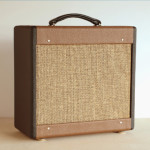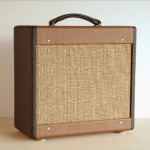Home › Forums › Design and Building › 2 Stroke Amplifier Design and Building › Dim Bulb Testing/power up
- This topic has 9 replies, 3 voices, and was last updated April 6, 2015 at 7:47 pm by
 Robin.
Robin.
-
AuthorPosts
-
January 6, 2015 at 6:52 am #5093
s3mamill
ParticipantHey guys, building the tester soon and hopefully firing my 2 stroke up this weekend.
When I start it the first time, should I have the tubes and speaker in the amp? I saw something on-line where a guy fired his up for the first time with no tubes. In the book DH just says “if there’s no sound when you start it, take it to your tech” with no mention of a dim bulb tester, so this is all new to me.
Thanks for any advice!
January 6, 2015 at 11:41 am #6038 RobinParticipant
RobinParticipantUse the current limiter! The idea behind starting the amp without the tubes is that some of the B+ circuit will not be complete and you could “potentially” find an issue (short) before you go full throttle. With the current limiter, you can fire up the whole circuit and if the bulb glows brightly, you know you have a short and it protects the circuit from frying the PT and other components. BTW, you might have read that the current limiter bulb will start out bight and then dim as the circuit warms up, this might happen, or the bulb might not light at all. That’s ok as long as you know you’ve constructed the limiter correctly. It’s only when the bulb starts bright and stays bright (indicating a short) that you need to be concerned.
DH’s suggestion is the safe route but if there is an issue with the amp and you take it to a tech right off the bat, you won’t have an opportunity to discover the problem and resolve it on your own. You can always use the amp tech as the last resort anyway. Many have built the Two Stroke and had it work great from the start, other’s have had issues but most are resolved with out much effort. I always use the current limiter when I build an amp or get an amp in for repair.
Be sure to have the speaker plugged in (or a dummy load) and don’t dime the volume if there is an issue. Triple check all your solder joints and use your meter to confirm all connections and grounds before you fire it up.
Good luck, it’s a really great amp.January 6, 2015 at 8:38 pm #6039s3mamill
ParticipantThanks for the advice Robin. I’ll fire it up using the limiter and with the tubes installed and speaker hooked up.
I’m thinking of using a 60w bulb in the limiter since that’s what I have at home. I read elsewhere that if you have a low power amp, use a low watt bulb. Does 60w seem okay if I have a 6v6 tube installed?
January 7, 2015 at 2:12 am #6040 RobinParticipant
RobinParticipantThat should be fine, I use a 100w bulb for everything. Also double check that you have polarity correct for all electrolytic caps (otherwise they go boom and make a mess).
 January 8, 2015 at 3:11 am #6041
January 8, 2015 at 3:11 am #6041s3mamill
ParticipantHere is a photo of the way my current limiter is wired. I wired it according to the other pic and the associated website. I’m having some trouble getting the bulb to light up though. With the 60w bulb in the top outlet I can get an amp to start, but the bulb never lights at all. I’m not sure if I didn’t wire it right or what. There seem to be different suggestions for wiring online.
The bulb lights if I plug it into another outlet in my house.
Any suggestions?
January 9, 2015 at 2:04 am #6042 RobinParticipant
RobinParticipantAs long as the sockets are wired in series and not in parallel and that you broke off the taps connecting the two sockets on the outlet, you should be good do go, you could test it by carefully shorting the socket (the one without the bulb) and the bulb should light up, full brightness. Before you do that, confirm that the bulb is know good (another good use for your meter) but you already checked it in another fixture. If you short it and the bulb does not light up but you blow a fuse (or throw a circuit breaker), then it’s not wired correctly. The bulb must be in one of the sockets to complete the circuit. As I mentioned previously, depending the current draw when you switch on the amp, the bulb may not light up at all.
January 9, 2015 at 2:12 am #6043s3mamill
ParticipantRobin, I was using a solid state amp (I was a little shy to plug in one of my tube amps) to test with when it didn’t seem to work. I ended up plugging a 5E3 in and got the bulb to dim. So plugged in the 2stroke…
January 9, 2015 at 2:26 am #6044 RobinParticipant
RobinParticipantYour experience with the Deluxe circuit is correct, be sure to disconnect the current limiter after you confirm the amp is working right, you will not get good performance or correct voltages with the current limiter installed.
April 5, 2015 at 1:13 am #6061Action Figure Studios
ParticipantHi,
I have a simply wired current limiter which I have not tested.
Note that when using an off-the-shelf extension cord, the hot lead is the one with the printing embossed on that line.
I mounted it to a board to clamp or screw to my work surface. It’s got a hole in it to hang up out of the way to protect the bulb when not in use.
What do you think? Just getting started.
Thanks!
April 6, 2015 at 7:47 pm #6065 RobinParticipant
RobinParticipantThe current limiter provides a way to ensure that the circuit plugged into it does not include a direct (dead) short, draw too much current and fry components, blow fuses and so on. It is possible that you could connect a circuit that does not draw much current and does not “light the light”. I have amps like that. I also have amps where the light glows brightly at start up, indicating a have current draw as the caps charge and tubes heat up, but then dims down as the amp warms up. Only when the light stay bright do you have an issue that needs corrected before removing the current limiter from the circuit.
BTW, remember to remove the current limiter from a circuit when checking voltages or setting bias.
-
AuthorPosts
- You must be logged in to reply to this topic.
